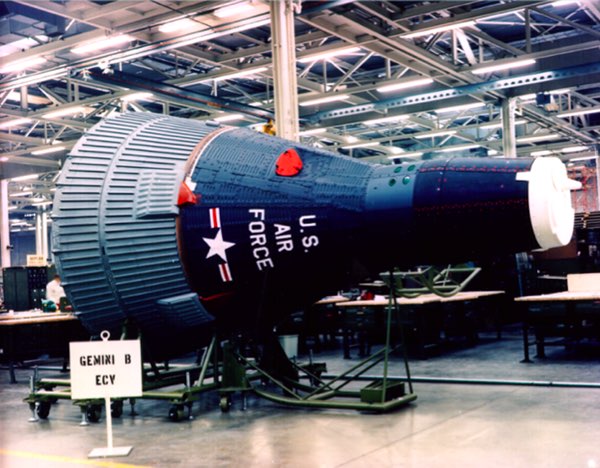Adapter in the roughby John Charles
|
| It was not lost as much as it was long neglected, hidden in plain sight in the wrong place as it gradually decayed. |
Specifically, it is the adapter module of the Gemini-B vehicle designed to carry US Air Force astronauts to and from their tours of duty aboard the Manned Orbiting Laboratory, or MOL, a series of single-use 1960’s-vintage manned spy satellites (despite the disingenuous name) to keep an eye on America’s Cold War adversaries.
It was part of a Gemini-B spacecraft engineering mockup from 1968 (see Figure 1 above), with some flight-worthy components and some simulated parts, but intended for ground evaluation instead of flight. The mockup was apparently designated the “ECV” which might have stood for “engineering configuration vehicle,” but no one I have asked can confirm that.
The adapter on Gemini-B and on its cousin, NASA’s Gemini (see Figure 2), connected the crew re-entry capsule to the rest of the launch vehicle stack. (The “B” version of the Gemini had MOL-unique modifications that distinguished it from NASA’s “A” version, which was never referred to as “Gemini-A” as far as I know.) The designers at the McDonnell Aircraft Co. were innovative and anxious to minimize weight as much as possible, so they ingeniously used that otherwise wasted volume to accommodate life support equipment, maneuvering systems, and experiments needed during flight but not during landing.1,2 , This kept the re-entry capsule’s weight to a minimum without sacrificing in-flight functionality.
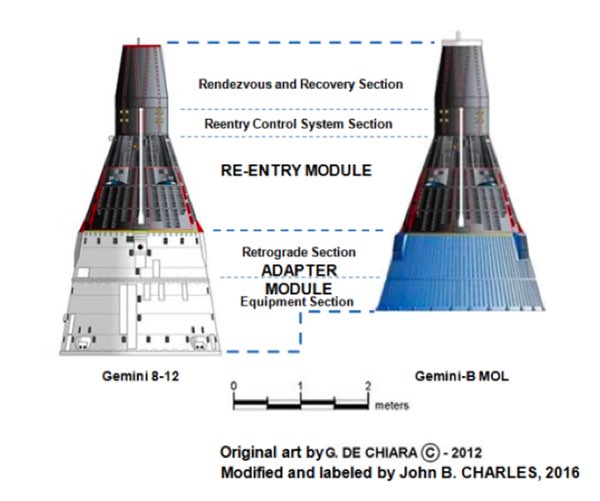 Figure 2. Comparison of NASA Gemini and USAF Gemini-B for MOL, with sections labeled. Original Art by G. de Chiarra, modified by J. Charles. |
By 1967, the now McDonnell-Douglas Astronautics Corporation considered the Gemini-B/MOL system to be sufficiently flexible and capable for future space station programs as well as for the secret military missions for which it was originally designed. It was marketed aggressively to NASA for space station use, unsuccessfully. Undaunted, the company decided to compete head-to-head with North American Rockwell’s Apollo command-service module assemblage for space station support. Their concept was the Big Gemini,3 or Big G, which enlarged the carrying capacity of the basic Gemini-B reentry module to accommodate up to 10 more astronauts or their equivalent in cargo by extending its length by 60 percent (see Figure 3). In particular, the removable hatch through the aft pressure bulkhead led not to a tunnel but into the additional crew compartment.
| Somehow, sometime, possibly in the early 1970s, this adapter unit was mixed in among other surplus items that seemed to represent Marshall, so it ended up on a pallet delivered to Huntsville, Alabama. There it sat. |
The Big G mockup must have initially used the existing Gemini-B engineering mockup as its basis, without its adapter section and with a modified rendezvous and recovery nose section, but a photograph of the Big G mockup from April 1969 shows the NASA Gemini, not the Gemini-B—and the Gemini-B adapter module standing in the background. The photo’s caption states clearly that the NASA Gemini is used in the mockup, and the paint job on the side of the capsule confirms it. Perhaps the Gemini-B mockup could not be used for the photo session because it had “U.S. Air Force” painted on its flank instead of NASA’s “United States,” poor strategy for marketing to NASA.
When MOL was cancelled in 1969 and subsequent bids to market the Gemini-B and Big G spacecraft to NASA lost out to Space Shuttle concepts, the now-McDonnell Douglas Corporation collected the MOL flight and ground hardware, including the ECV mockup, and either scrapped it or offered it to the Smithsonian Institution. By law, the Smithsonian is the official repository for important government space artifacts and keeps or distributes those it deems representative and important. Somehow, sometime, possibly in the early 1970s, this adapter unit was mixed in among other surplus items that seemed to represent Marshall, so it ended up on a pallet delivered to Huntsville, Alabama. There it sat.
We knew where the adapter was in 2006 because Tom Hancock, a space historian in Huntsville, had posted photographs of it on the Internet in his “US Space News” (now retired). He occasionally visited it in the outdoor storage area, or “boneyard,” of the US Space and Rocket Center in Huntsville. The USSRC, originally the Alabama Space and Rocket Center, is the visitor center for NASA’s Marshall Space Flight Center, and it is full of mockups, prototypes, and spares of spacecraft and their systems from the Apollo, Skylab, and Shuttle programs for which Marshall was responsible.
This boneyard is like most outdoor storage areas for museums, schools, factories, and my grandmother’s farm. Pieces of machinery and other items with no planned use but possible future value sit in the open air, usually grown up in weeds and inhabited by wildlife.
I had seen the Gemini-B ECV crew capsule, or re-entry module (see Figure 3), on several visits to the National Museum of the U.S. Air Force at Wright-Patterson AFB near Dayton, Ohio, most recently at the October 2015 “MOL declassification event” staged by the NRO. This was the NRO’s way of announcing the new public accessibility of 825 documents, 282 photographs, and one short movie clip on MOL, all previously classified as “secret.” The museum’s Gemini-B has long been displayed as an example of NASA’s Gemini, albeit without its adapter module, its rendezvous and recovery nose section and both of its hatches, but that always seemed like a wasted opportunity to showcase the Gemini-B’s unique characteristics. Then again, maybe that deception was appropriate for a top-secret spy satellite.
 Figure 3. Gemini-B reentry module, possibly the same ECV as in Figure 1, now on display at the National Museum of the U.S. Air Force, Wright-Patterson AFB. Photo credit: Jim Cope, USAF. |
When I say confidently that this display vehicle is the ECV, it is an act of faith on my part based on deduction. The only known photographs of a vehicle in the Gemini-B configuration are of the ECV in about 1968 at the McDonnell Douglas plant in St. Louis, Missouri. No Gemini-B flight vehicles were ever constructed,4 so I assume that the vehicle now on display in Dayton is the ECV. Eventually I mentally connected the Gemini-B adapter module in the USSRC bone yard with the capsule in Dayton, although their physical and geographical separations gave me pause.
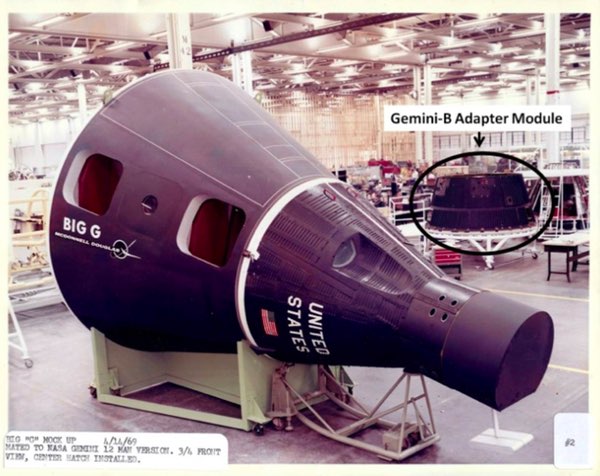 Figure 4. Big Gemini mockup at McDonnell Douglas in St. Louis, April 1969. At the core of the mockup is the “NASA Gemini,” possibly for marketing purposes, even though the concept required the Air Force MOL Gemini-B variant for it to be usable. Photo by McDonnell Douglas, courtesy Dr. Dwayne Day. |
The NRO event is also where I first met Mike Jenne, an author whose breakout work is an alternate history trilogy5 about clandestine Cold War space missions aboard modified Gemini spacecraft. It is carefully researched as well as well-written, and I quickly appreciated Mike’s grasp of the subject matter.
So, it was that, on June 29, 2016, eight months after the NRO event, I emailed Mike to see if he would be interested in a MOL-related challenge: reuniting the capsule in Dayton with the adapter in Huntsville, so they could be displayed in Dayton, together for the first time in decades. He accepted the challenge.
| That was discouraging, but I began to accept that it was gone, scrapped or otherwise disposed of, or dissolved unrecognizably into the weeds and dirt. |
A few days later, on July 3, Mike drove north from his home near Birmingham to Huntsville to reconnoiter the bone yard. He is retired Special Forces, so he prepared for this mission by looking at overhead imagery of the boneyard from Bing and Google Earth. Based on his research for the trilogy, no one could have been better prepared for this quest. Actually, it was multiple quests: others in his network of space history buffs had suggested their own favorite space artifacts as targets, so he had a shopping list.
After his visit, Mike emailed that he hadn't been able to find the adapter. The closest he came was a fiberglass cylinder over near the Titan II ICBM display model, but with none of the expected internal features, especially the crew transfer tunnel, and larger than the 10-foot diameter of the Titan rocket which was to be MOL’s launcher. That was discouraging, but I began to accept that it was gone, scrapped or otherwise disposed of, or dissolved unrecognizably into the weeds and dirt.
However, Mike is more persistent than me. A couple of days later, on July 5, as he searched through the Bing and Google Earth overhead photos again, he spotted an inconspicuous cylindrical item that he had seen but dismissed during the visit. I sent him Hancock’s pictures from 2006 and told him the adapter is a tapered cylinder 10 feet (3 meters) across at its wide end, 7 feet (2.1 meters) at its narrow end, and 5 feet (1.5 meters) high. When I confirmed it was probably gray, unlike the white Gemini adapter he had been looking for (oops, did I not mention that difference before?), he was convinced this was the missing item.
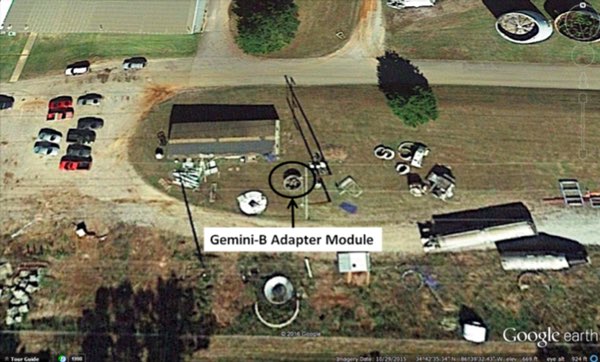 Figure 5. Google Earth view of USSRC bone yard dated Oct. 29, 2015, showing location of Gemini-B adapter module. Screen capture by J. Charles from Google Earth. |
The adapter is barely recognizable in the low-resolution Google Earth image from October 29, 2015 (Figure 5), sitting 16 feet southeast of a storage building at the western end of the USSRC complex: look for it at 34 degrees, 42 minutes, 35.38 seconds north, 86 degrees, 39 minutes, 32.49 seconds west.
Coincidentally, Hancock reposted some of his 2006 images on the Space Modeling page on Facebook on that same day,6 reinvigorating public interest in the item.
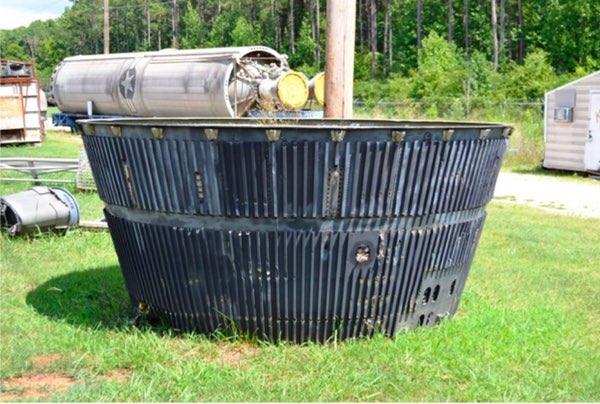 Figure 6. Current location and condition of Gemini-B adapter module at USSRC bone yard. Photo by Mike Jenne, July 17, 2016. |
Mike returned to the bone yard on July 17, two weeks after his first visit, and went straight to the artifact. It was as if I were there, too, because he sent me pictures from every angle as he inspected it (see Figures 6 and 7). It was surprisingly recognizable after having been exposed to the elements for at least a decade and probably much longer.
How much longer is not clear. Available imagery does not show where it was when Hancock photographed it in 2006, but something that resembles it was 60 feet (18 meters) further to the south, across an access road, from 2007 to 2013.
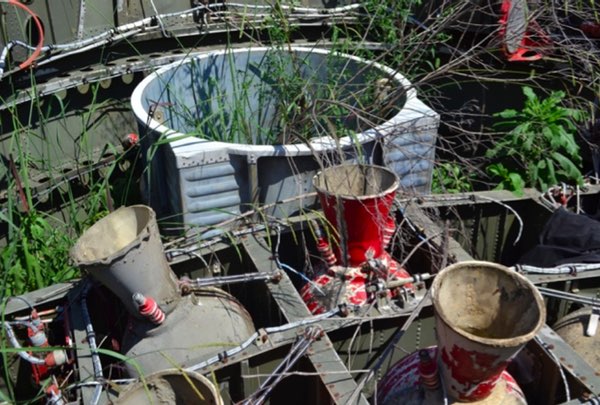 Figure 7. Detail of Gemini-B adapter module showing crew transfer tunnel (top) and retrorocket assembly (bottom) with five of the six original simulated retro rockets still in place. Photo by Mike Jenne, July 17, 2016. |
And there the story might have ended, except for a whim. My wife and I have been discussing a post-retirement plan to buy a recreational vehicle and use it to see the country affordably. We decided to “practice” retirement this year on a weeklong road trip in a rented RV. Driving from Houston to Huntsville would provide the needed distance and scenery, so I asked Mike if he was up for another trip to the boneyard. He was, and recruited two friends in Huntsville to meet us there. One of them was Tom Hancock, who had taken the very photos that had inspired our search. We were escorted by Ed Stewart, Director of Exhibits and Curation.
That is how, on the sweltering sunny morning of August 24, I found myself in the USSRC bone yard with four other space history buffs approaching the adapter. It wasn’t a profound or moving experience but it was gratifying to see it for myself and to imagine it as it once was. I immediately recognized the vestiges of the simulated retrorockets, the crew transfer tunnel, and the empty fixtures for the oxygen and water tanks. We searched for data plates on every piece and established that most of it had been built by October 1967—49 years ago. With the USSRC curator, we immediately started scheming how to rescue it from the elements, refurbish it and put it on display somewhere. All those steps would require funding as well as a destination, although the curator said he would try to move it indoors in the mean time. The USSRC never had any connection to MOL—aside from this adapter’s unexpected and unrequested delivery—so the problem also included shipping it somewhere else that did have a connection.
The obvious “somewhere else” is the National Museum of the US Air Force (NMUSAF). The museum’s Gemini-B crew capsule was, I believe, originally paired with the adapter module now at USSRC as the complete ECV of 1968. Thus, it makes sense that they should be reunited and displayed there among the museum’s unique collection of unmanned reconnaissance satellites.
However, here is where the realities of museum operations complicate matters. First, the adapter is officially the property of USSRC, and they would have to transfer it. This part sounds easy, because the USSRC curator said he would support such a decision. Second, as John Luchin, Registrar of the Collection Management Division, explained, the NMUSAF establishes its restoration and exhibit projects and budget years in advance, so even if they acquired the adapter, it could sit in storage for years.
| It wasn’t a profound or moving experience but it was gratifying to see it for myself and to imagine it as it once was. |
Storing it indoors at the Air Force museum in Dayton seems preferable to leaving it outdoors at the NASA museum in Huntsville, and not just because of the ravages of nature. There is apparently also larceny involved. One of the six simulated retrorockets is missing, and Hancock recalls an earlier visit to the artifact when all six were present. On the day that Mike took pictures of it at USSRC, a security guard said that the USSRC had experienced problems with people raiding the bone yard for scrap metal, particularly aluminum. If anyone suspected the market for these and other rare historical artifacts—perhaps a collector wanting something to go with his purloined simulated retrorocket—then four men and a pickup truck could bring our story to an untimely end.
At least such a collector would recognize the significance of the MOL program. Even if we considered it a failure because it was cancelled before its first flight, MOL was a massive undertaking in which thousands of workers labored and billions of taxpayer dollars were expended. The Air Force press release announcing its cancellation said that “about $1.3 billion had been spent to date” on MOL, equivalent to $9.4 billion in 2015.
Despite that mind-boggling investment, there are practically no MOL artifacts remaining: aside from repurposed launch pad in California now used for commercial launches and an augmentation to the Air Force’s mission control center, also in California, there are only a flown heat shield test capsule in Florida, the intact mockup crew capsule at the NMUSAF, the less-intact mockup adapter module at the USSRC, three or four blue Hamilton-Standard spacesuits, and an alligator clip-lined aluminum sheet labeled a “prototype food dispenser for the Manned Orbiting Laboratory, one of the very few full-scale objects to survive the MOL project…” The scarcity of physical artifacts associated with the MOL program would seem to be adequate motivation to properly preserve this piece of history.
It is clear that any progress will require coordination and collaboration at high levels. The first step might be to identify who those high-level decision-makers are so they can specify the steps required at USSRC and NMUSAF to effect the transfer: who has approval authority, what has to be approved, in what order, for which options (restore, refurbish, display as is or other option) and most importantly what it would cost. Presumably items are shared among museums all the time, so how has it been done before? If it isn't on their multi-year plan, what would it take to get it into that plan?
Whatever fate the future holds for the adapter, I think it was appropriate and not at all ironic that we pinpointed this artifact—a vestige of a high altitude photographic spy program—by examining high altitude photographs of the target area. That’s the kind of closure that you usually only get in the movies.
Endnotes
- Grimwood, James M., and Hacker, Barton C., with Vorzimmer, Peter J, Project Gemini, Technology and Operations, A Chronology, NASA Special Publication-4002, Washington, D.C.: NASA, 1968 (accessed Dec. 24, 2016). See entries for July 7 and July 27-28, 1961, in PART I (A), Concept and Design, April 1959 through December 1961.
- Kolcum, Edward H., “Manned Space Flight Program Expanded; McDonnell to build 12 two-man capsules and modify four Mercury spacecraft for flights of 18 orbits,” Aviation Week & Space Technology, Dec. 18, 1961, pp. 26-7 (accessed Jan. 1, 2017; subscription required).
- Petty, Chris B, “Space Trucks! Big G and the TKS,” The High Frontier (blog), Dec. 14, 2015 (accessed Dec. 25, 2016); Day, Dwayne, “The Big G,” The Space Review, Dec. 7, 2015 (accessed Dec. 25, 2016).
- “Program Schedule Status, 10 June 1969”, (accessed Jan. 9, 2017), pp. 22 of 41, item IV.
- Blue Gemini, Blue Darker Than Black, and Pale Blue, Yucca Publishing (New York, NY).
- Hancock, Thomas, Facebook post, July 5, 2016, (accessed Dec. 26, 2016).
